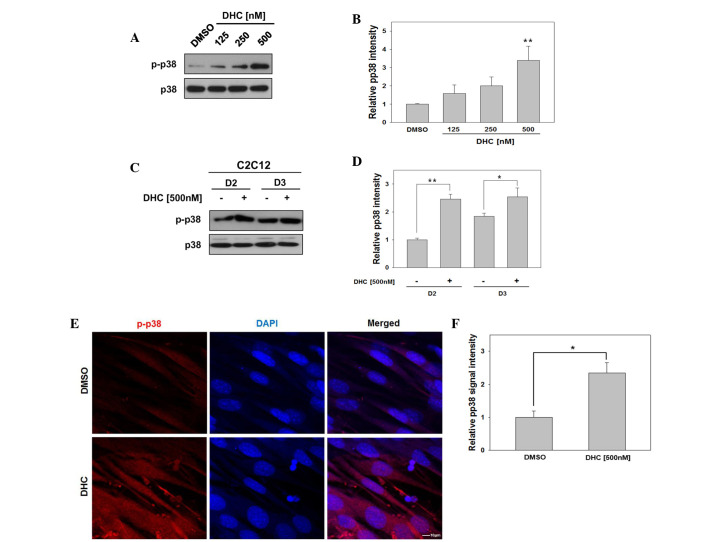Figure 2.
Dehydrocorydaline (DHC) activates p38 mitogen-activated protein kinases (MAPK) in myoblast differentiation. (A) C2C12 cells were treated with DHC and induced to differentiate for 2 days (D2). Lysates underwent western blotting with antibodies against phosphorylated-p38 MAPK (p-p38) and total p38. (B) Quantification of three replicate immunoblots, one of which is presented in (A). The intensity of the p-p38 and p38 signals were quantified, and the values were obtained from a ratio of p-p38/p38. Data are presented as the mean ± standard deviation (SD) from triplicate determinations. *P<0.05 and **P<0.01 vs. the dimethyl sulfoxide (DMSO)-treated group. (C) C2C12 cells were treated with DHC for D2 and 3 days (D3). Lysates were immunoblotted with antibodies against p-p38 and total p38. (D) Quantification of three replicate immunoblots, one of which is presented in (C). The intensity of the p-p38 and p38 signals were quantified, and the values were obtained from a ratio of p-p38/p38. Data are presented as the mean ± SD from triplicate determinations. *P<0.05 and **P<0.01 vs. the DMSO-treated group. (E) C2C12 cells were treated with DMSO or DHC, fixed and stained with antibodies against p-p38 (red), followed by 4′,6-diamidino-2-phenylindole (DAPI) staining (blue). Scale bar, 10 μm. (F) Quantification of p-p38-positive cells presented in (D). Data are presented as the mean ± SD from triplicate determinations. The experiment was repeated three times with similar results. *P<0.05.

